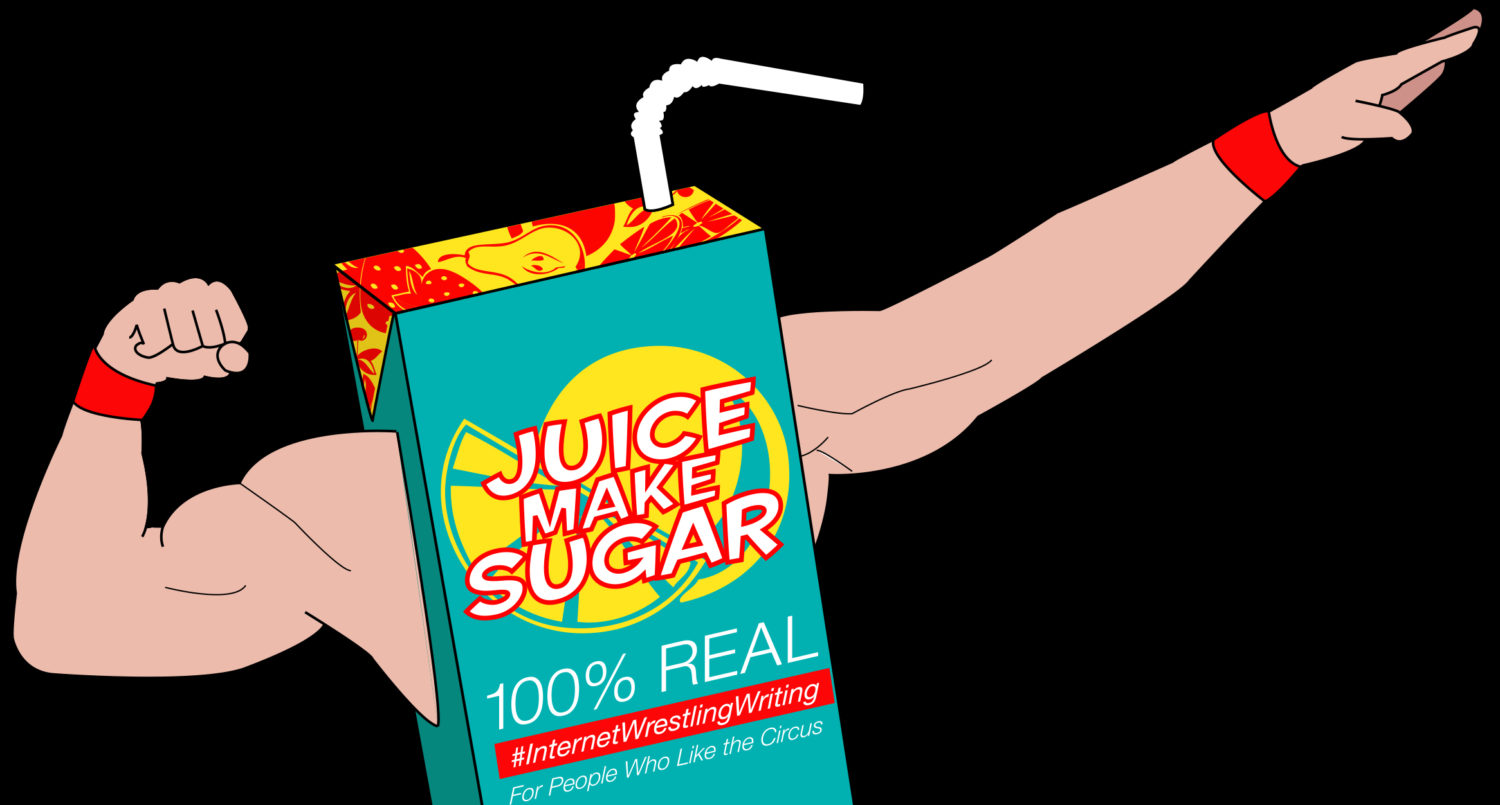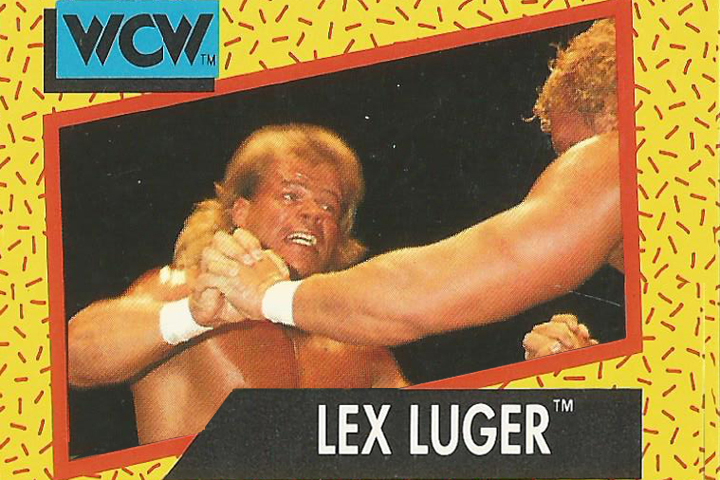It’s Day Two of #LexLugerWeek, the eighteenth installment of our (patent pending) Juice Make Sugar Wrestler of the Week series. Today, we give you the finer points of the Larry Pfohl oeuvre with some Essential Viewing (Bruiser Brody no-sell freak out not included, but don’t worry, we’ll get there.)
If you were taking notes during Ric Flair week, you shouldn’t be surprised that Lex Luger’s all-time great opponent was Ric Flair. Flair could wrestle a broomstick, and Lex Luger was the Dyson of impressive-looking broomsticks. While he may have tallied more ring time with Sting at (or near) the top of cards, it was Flair who came the closest to making Luger a true main event star who could work main event matches.
The idea of strength in wrestling is a relative illusion, created through respect, cooperation, and possessing at least twenty percent of the strength you purport to have. With the help of Flair, Luger looked like the strongest man in wrestling. Flair could sandbag and then leap into cooperation in a way that made Luger’s lifts look like the acts of a circus strongman, then fly and bump in ways that made it seem like they were wrestling in a world of comic book physics.
Unfortunately, without the talent and enthusiasm on an opponent like Flair constantly across the ring, Luger could never really put together a great match or conceive a great moment on his own. When it comes to Luger’s match with Barry Windham at the Great American Bash, I don’t think I could explain things any better than Nick did yesterday:
“The make-up match at the same PPV with a capable though ultimately underwhelming Barry Windham would see him finally get his run with the big belt, but lose all of the momentum he had going into the match with an idiotic heel turn at the behest of Harley Race and Mr. Hughes. After having the wind taken out of his sails by the nonsensical turn, Luger would play out essentially play out the string…”
Through a post-Vince Russo, post-Attitude Era lens, this heel turn almost seems, well, cool. Why would jacked, inherently-mean-looking Lex Luger play patty cake with tall but soft-bodied Barry Windham to see who the better man was? Why wouldn’t he use the piledriver, the last move that people still believe in, to assert himself as the evil top dog? Well, dummy, because the fans didn’t want to boo flint-eyed, evil cartoon supervillian Lex Luger, they wanted to cheer blonde-haired, blue-eyed cartoon superhero Lux Luger. In a booking mistake that persists to this day, WCW chose to cop out of their unspoken contract with fans at the most scarring possible moment for Luger’s long-term marketability.
https://youtu.be/KWZELkJeGgM?t=413
When Luger made it to the WWF (which is a crazy, convoluted story of all its own involving Luger fulfilling literally the bare minimum of his WCW contract obligations while champion, asking to be released, promising that he would only participate in the WBF and never wrestle for Vince, and then wrestling for Vince), he seemed destined to be back on the track toward greatness. Luger was the kind of wrestler Vince McMahon would wait in line overnight to push: his impossible-without-a-lot-of-help physique and gigantic-Aryan-next-door countenance contained the angles and curves that would look great on a cereal box or a t-shirt or an action figure. And so it was that Lex Luger got one of the most spectacular introductions to the WWF audience in company history:
Nick made his jokes about it yesterday, but I have to get mine in. This is so cartoonishly homoerotic that Freddie Mercury would have found it campy. I can’t even begin to imagine the awesome but deeply confusing feelings this segment brought out in a certain percentage of WWF fans. Easy jokes aside, though, this vignette is one-hundred-percent dedicated to strapping a rocket to Luger’s back (or maybe… uh… up somewhere else) and blasting him off into the stratosphere.
For a number of reasons, The Narcissist gimmick didn’t work. For one thing, the early ‘90s was a rough time to try and get over in the WWF if you didn’t have holdover credibility from the Hogan era. Perhaps more importantly, however, accentuating the Gamma Ray-induced figure that was Luger’ biggest asset was dangerous ground for Vince McMahon, against whom prosecutors were building a strong case for large-scale steroid distribution charges at the time. Maybe The Narcissist didn’t get over because Vince was afraid to go full-bore for fear of prison, maybe it was because Bobby Heenan couldn’t say the name right, or maybe it was because Luger just wasn’t good enough to make it work.
However, from the ashes of The Narcissist rose the all-time face push for Luger: ‘MERICA! One of the principal narratives told throughout wrestling history has been one of nationalism (read: xenophobia), and in a company that had made money off of Bruno Sammartino’s American Dream gimmick, Bob Backlund’s All-American Boy gimmick, and Hulk Hogan’s Real American gimmick, it seemed clear that the formula was to take Luger, drape the red, white, and blue over his shoulders, and strap the wagon to him.
Of course, the subtlest possible way to make someone an American hero is to have them wear only red, white, and blue, put them on a flag print bus, and have them conquer the “pretending to be the Yellow Peril” Yokozuna (seriously, how awesomely American racist is it to make a Pacific Islander Japanese?) on a freaking battleship:
Luger’s slam of Yoko on the Intrepid was meant to be Hogan’s Wrestlemania III slam of Andre on steroids (pardon the expression), but once again, even with a huge push and an opportunity for what should have been a signature moment, Luger proved himself unable to get half as over as he should have been. As Nick covered yesterday, this led to Lex’s massive booking plans being rather sawed off. If Lex Luger was ever going to be become a big, main event star, it would have happened at Summerslam ’93. Let’s see how that worked out:
Eric Bischoff and Lex Luger can talk all they want about Luger’s appearance at the first episode of Nitro in the fall of ‘95 being a big coup, but the fact of the matter is that it wasn’t. Luger had failed and burned bridges in WCW, failed and burned bridges in the WWF, and somehow in spite of hundreds of hours of television time, had never actually gotten over in any meaningful, lasting way. Lex’s in-and-out runs in WCW from ’95 – 2000 were utterly meaningless, and generally just a platform for Tony Schiavone to say, “OH MY GOD, THAT’S LEX LUGER!” Just as had been the case with The Narcissist in the WWF, Luger’s value was largely in debuting and looking awesome, but then, unfortunately, at some point he had to wrestle.
In some ways, Luger’s body and pushes tells the story of the fall of WCW. He fought Hulkamania when it was the in thing to do, joined the nWo when it was the in thing to do, and changed his well-known name to an utterly Vince Russo gimmick name when it was the in thing to do, all the while getting more anabolically terrifying.
As if finally admitting that Luger would never live up to the potential he showed in the late ‘80s, WCW placed Luger in a tag team with Buff Bagwell called “Totally Buffed.” To illustrate how terrible this was, here’s Totally Buffed wrestling Kronik, the certified two-time Wrestling Observer Worst Tag Team of the Year award winners:
https://www.youtube.com/watch?v=qrdMeP2SgXk
Some wrestlers’ careers tell tragic stories, others spectacular tales. As can be seen through just a few short clips and matches, Lex Luger’s career tells an honest-to-god story of merit in the orchestrated world of professional wrestling. No matter how often and how vigorously wrestling’s brightest minds and deepest pockets tried to push him, Luger never rose to true top guy status because, well, he didn’t deserve it.



RT @JuiceMakeSugar: #LexLugerWeek: Essential Viewing w/ @DavetheMark http://t.co/axDOBqPoNU
ICYMI, it’s #LexLugerWeek at JMS!
Better Know w/@THEN1CKSTER: http://t.co/0puY97Sj3S
Essential Viewing avec moi: http://t.co/io54aDDR0G